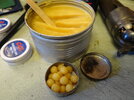The 1000fps out of my 1860 is with a round ball. That's with 33 grains of Scheutzen 4fg. In my Remington, I can get 34 grains under a 207 grain bullet, but I have not chronographed it.
View attachment 1207614
Don't slather crisco. Just press a lube-pill over the ball. Faster than putting a wad under the ball (or bullet) and the results are amazing. Yes, crisco is an absolute mess.
4fg being priming powder is a myth. Originally, rifles and muskets were primed out of the horn, with whatever was being used for the main charge. I believe 4fg was originally referred to as "fine pistol powder". As far as anyone knows, there has never been a container of 4fg labeled as "priming only". However, the myth marches on. Except for my single shot, .54 caliber Plains Pistol, I use 4fg in all my handguns. (my vast collection of four)
As I carry/use my pistols in the field, I load them all with a maximum charge. (except the 1862)
My .36 Remington will take 30 grains 4fg under a ball, and 24 under a 140 grain slug.
The 1860, as mentioned will take 33 grains 4fg under a ball, (or 34?) and ball is all I shoot out of it, just seems to like it best.
My Remington in .44 will take a little more than the Colt, I can get 33-34 grains 4fg under a 207 grain slug in it. That pops off pretty good. I think it will take around 37+ grains of 4fg under a ball, but it's my "slug gun", or what I take when I want maximum smack down from a cap-n-ball. (without going to a very heavy revolver such as a Walker or Dragoon)
The 1862 Pocket Police won't take much more than about 22 grains under a ball, but that penetrates through a 2X6 no problem, the purpose of that pistol is for taking small game should a wilderness survival situation ever occur, but I think it would put some hurt on a wolf or cougar if needed. I get very fine accuracy in that pistol with 4fg. It will only take 15 grains under a slug, and that load will not penetrate as far as the ball over 20-22 grains. So in that pistol, the ball is a better choice, and again, it's for popping off rabbits and grouse if I'm starving.

Those are all measures by weight, not volume. In the field, I have different spouts on my small pistol flasks that throw those weights, more or less. Usually I trim them for slightly less, so I don't get a high seated ball or bullet when reloading in the field, in a tense situation. That would suck. When loading them up at home before heading out I use the scale. I also take some paper cartridges for faster reloading in case the cougars and wolves are all attacking at once. (the rifle or musket will take care of any bear problem) The cartridges require less powder to fully seat, so if time permits loose powder and ball gives me a slightly heavier charge so that's what I prefer to use.
Hope that helps...that's one heck of a lot of blah-blah-blah-yada yada....but I type too fast.



